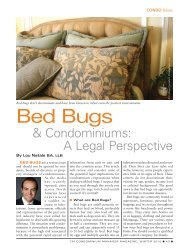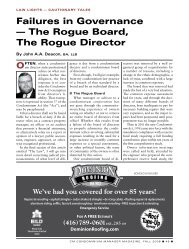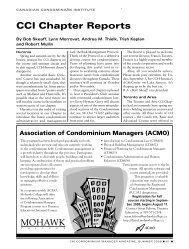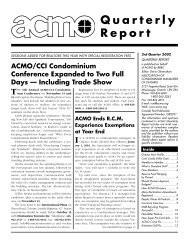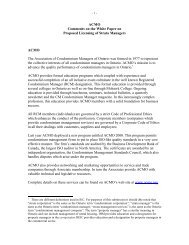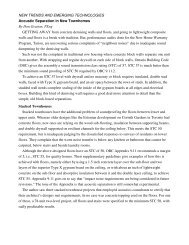Water Leaks - Association of Condominium Managers of Ontario
Water Leaks - Association of Condominium Managers of Ontario
Water Leaks - Association of Condominium Managers of Ontario
You also want an ePaper? Increase the reach of your titles
YUMPU automatically turns print PDFs into web optimized ePapers that Google loves.
EMERGING TRENDS & New Technologies<br />
Pinhole<br />
<strong>Water</strong> <strong>Leaks</strong><br />
What are they,<br />
why do they<br />
happen and<br />
what to do<br />
about them<br />
By Wolfgang Osada<br />
SOONER OR later, all domestic<br />
hot water pipes in condominiums<br />
leak. In fact, it’s happening<br />
to younger and younger buildings.<br />
Dubbed “pinhole” leaks because <strong>of</strong><br />
the telltale pattern <strong>of</strong> internal pipe<br />
erosion that causes the problem, as<br />
a manager you need to understand<br />
why leaks occur and how best to<br />
repair them.<br />
■ Why Highrise Pipes Leak<br />
Constantly flowing water is why<br />
pinhole leaks happen and on the hot<br />
water side <strong>of</strong> highrise water systems<br />
only. In order to make hot water<br />
immediately available at all taps,<br />
pumps constantly circulate water<br />
into and out <strong>of</strong> a large central water<br />
tank through a network <strong>of</strong> horizontal<br />
headers and vertical pipes called<br />
risers. These risers are never more<br />
■ 18 ■ CM CONDOMINIUM MANAGER MAGAZINE, SUMMER 2011
than a few feet from faucets, tubs<br />
and showers, so hot water begins<br />
to flow quickly whenever taps are<br />
turned on. As useful as this design<br />
is, internal erosion <strong>of</strong> copper pipes<br />
is a side effect. The cold water side<br />
<strong>of</strong> the system doesn’t circulate continuously,<br />
so there’s no pinhole erosion<br />
problem.<br />
■ Stop-Gap Repairs<br />
Pinhole leaks always occur, occasionally<br />
at first, and that’s why<br />
the most popular initial strategy<br />
is to patch them as they happen.<br />
Screw clamps holding self-fusing<br />
silicone tape in place around the<br />
outside surface <strong>of</strong> the pipe is the<br />
usual repair method, but there are<br />
three problems with this approach:<br />
unnecessary risk, additional pipe<br />
damage and technical futility.<br />
If a building has experienced a<br />
few pinhole leaks, you can be sure<br />
that others are coming, with the<br />
rate <strong>of</strong> new leaks certain to rise<br />
over time. That’s the nature <strong>of</strong> internal<br />
hot water pipe erosion. It occurs<br />
throughout the entire system<br />
Pipe lining costs a good 20% less than repiping ... while typically<br />
delivering a longer working life.<br />
with the deepest areas <strong>of</strong> erosion<br />
surfacing where internal turbulence<br />
and water flow is greatest.<br />
Managing a building with pinhole<br />
leaks is like walking through<br />
a minefield. You never know if the<br />
next step will be harmless or devastating.<br />
That’s because pinholes<br />
can happen in places where leaked<br />
water causes little trouble, or where<br />
one single leak translates into many<br />
thousands <strong>of</strong> dollars <strong>of</strong> property<br />
damage.<br />
Pinhole leaks always indicate the<br />
progressive overall weakening <strong>of</strong> a<br />
highrise water system, and pressure<br />
CM CONDOMINIUM MANAGER MAGAZINE, SUMMER 2011 ■ 19 ■
from screw clamps used for repairing<br />
leaks from the outside <strong>of</strong>ten<br />
makes matters worse. The stress<br />
placed on neighbouring areas <strong>of</strong><br />
metal encourages leaks where pipes<br />
were previously watertight. That’s<br />
why the seemingly frugal strategy<br />
<strong>of</strong> patchwork repairs quickly becomes<br />
an expensive exercise in futility.<br />
Not only do the repair bills<br />
add up, but constant water damage<br />
angers residents and causes anxiety<br />
about mould.<br />
■ Traditional Pipe<br />
Replacement<br />
Cut out the bad pipe and put in<br />
the new. This is the pipe replacement<br />
strategy in a nutshell and it’s<br />
an obvious solution to the problem<br />
<strong>of</strong> pinhole water leaks. The main<br />
challenge is gaining access to the<br />
pipes. Cutting open walls (sometimes<br />
involving the interior <strong>of</strong> condo<br />
units), removing old pipes and<br />
replacing them, then re-establishing<br />
finished wall surfaces works, but<br />
you need to prepare your residents<br />
for disruption and mess.<br />
There are three main things to<br />
understand about the pipe replacement<br />
option. First, replacing old<br />
pipes with copper is not necessarily<br />
going to prevent leaks long term,<br />
especially if a building has begun<br />
to spring leaks at an early age.<br />
Whatever water flow conditions led<br />
to erosion in the first place won’t<br />
change with the mere replacement<br />
<strong>of</strong> pipes. These conditions need to<br />
be addressed separately, though<br />
that’s not always easy.<br />
To gain the most from a copper<br />
pipe replacement job, the new pipe<br />
needs to be the thicker-walled Type<br />
L version, not the more economical<br />
and common Type M copper. Also,<br />
consider installing automatic flow<br />
control valves that adjust hot water<br />
recirculation flow rates to minimize<br />
the effects <strong>of</strong> erosion.<br />
■ Repair from the Inside<br />
Out<br />
Epoxy pipe lining is a technique<br />
for applying a waterpro<strong>of</strong> coating<br />
to the inside surfaces <strong>of</strong> existing<br />
and leak-prone pipes as they sit<br />
in place. This is a mature process<br />
that’s <strong>of</strong>fered by different application<br />
companies. Developed in Japan<br />
and Europe, the process is newer<br />
to North America but has gained<br />
significant traction in recent years.<br />
Rikos is the industry-leader with 20<br />
years <strong>of</strong> specialization in highrise<br />
recirculation system pipe lining and<br />
delivering a complete solution to<br />
pinhole leaks. One <strong>of</strong> the reasons<br />
pipe lining works so well is because<br />
<strong>of</strong> the way pipes erode under the<br />
influence <strong>of</strong> turbulent water.<br />
Pipe erosion does not happen<br />
consistently across internal pipe surfaces.<br />
Various patterns <strong>of</strong> water flow<br />
turbulence cause irregular erosion,<br />
and this is an important fact. Just<br />
because highrise pipes leak, does<br />
not necessarily mean that the entire<br />
pipe wall is uniformly paper thin<br />
and ready to collapse. The reality<br />
is a pockmarked internal surface<br />
with many areas <strong>of</strong> substantial metal<br />
thickness, punctuated by small zones<br />
<strong>of</strong> weakness. These are where leaks<br />
happen and they’re ideally suited<br />
to filling and sealing. Epoxy-lined<br />
■ 20 ■ CM CONDOMINIUM MANAGER MAGAZINE, SUMMER 2011
pipes end up with an internal coating<br />
that’s several mms thick in areas<br />
with little erosion, and thicker as<br />
needed to fill weaker spots. The epoxies<br />
used are tested and approved<br />
for potable water contact situations,<br />
and they deliver 40 to 60 years <strong>of</strong><br />
useful service.<br />
Lack <strong>of</strong> disruption to buildings<br />
and residents is the main advantage<br />
<strong>of</strong> the epoxy lining process. No walls<br />
need to be cut, few pipes replaced<br />
and no redecorating <strong>of</strong> walls completed<br />
after the fact. Less trash goes<br />
to landfill, too. The process involves<br />
draining and drying the inside <strong>of</strong> specific<br />
riser pipes isolated from the rest<br />
<strong>of</strong> the system before liquid epoxy is<br />
distributed through the pipes using<br />
hot, compressed air. This liquid<br />
solidifies to a smooth hard coating,<br />
ready for water flow again about 24<br />
hours later. The low-friction internal<br />
surface <strong>of</strong> lined pipes boosts water<br />
flow rates and pressures, especially<br />
in higher floors.<br />
Pipe lining costs a good 20% less<br />
than repiping (drywall repair and<br />
security costs add to the repipe pre-<br />
Proper System Management<br />
Combats Shortening Pipe Life<br />
It used to be that it took 20 years for pinhole water leaks to<br />
emerge, but today some highrises are springing them after 15<br />
years service. It’s not unusual to see leaks in buildings less than<br />
10 years old. Some leaks are happening in buildings just 4 years<br />
old. One reason is the tendency to design buildings with fewer<br />
risers, smaller diameter water pipes, over-sized pumps and faster<br />
water recirculation flow rates. Regardless <strong>of</strong> what you’ve got,<br />
you can maximize the service life <strong>of</strong> any pipe system by following<br />
several steps. Performing a pipe condition assessment is one,<br />
as well as monitoring and balancing water circulation flows. The<br />
slower the water flow, the slower the erosion rates. As a manager<br />
you must also alert board members about the need to accumulate<br />
adequate reserve funds for the inevitable expense <strong>of</strong> dealing with<br />
pinhole leaks using more than just stop-gap patches. Take your<br />
pinhole leaks seriously. They are rarely an isolated event and they<br />
are increasingly appearing in buildings <strong>of</strong> all ages.<br />
CONDOLAW.TO<br />
2300 Yonge Street, Suite 2900<br />
P.O. Box 2384 Toronto <strong>Ontario</strong><br />
Canada M4P 1E4<br />
T<br />
F<br />
w<br />
416 489 5677<br />
416 489 7794<br />
condolaw.to<br />
CM CONDOMINIUM MANAGER MAGAZINE, SUMMER 2011 ■ 21 ■
MID<br />
CONSTRUCTION<br />
LIMITED<br />
APPLICATOR OF SMIDCRETE®<br />
EXTERIOR EXPANSION JOINT SYSTEMS<br />
BY SMID SYSTEMS INC.<br />
www.smid.ca info@smid.ca tel: (905) 686-2721 fax: (905) 686-2708<br />
Make the dream<br />
<strong>of</strong> condo living<br />
come true.<br />
PARKING GARAGE RESTORATION<br />
<br />
<br />
<br />
<br />
<br />
<br />
Expansion Joints<br />
<strong>Water</strong>pro<strong>of</strong>ing and Sealing<br />
Concrete Repair<br />
Traffic Coatings<br />
Carbon Reinforcement (Beams/Columns)<br />
Post-tension Repairs/Replacement<br />
1960 2010 50th<br />
mium), while typically delivering<br />
a longer working life. That said,<br />
care has to be taken when soldering<br />
afterwards because excess heat can<br />
cause delamination <strong>of</strong> the lining.<br />
Generally, most in-suite renovations<br />
are far enough from the risers and<br />
are not a concern. Most application<br />
companies, Rikos included, <strong>of</strong>fer a<br />
10-year warranty, though ask for<br />
and check references from lining<br />
firms before making any decisions.<br />
Hot water system maintenance<br />
is an expensive, inevitable and<br />
high-stakes condominium management<br />
issue. How you handle this<br />
challenge has a substantial effect<br />
on your pr<strong>of</strong>essional reputation.<br />
Information, planning and an understanding<br />
<strong>of</strong> the technical side<br />
<strong>of</strong> the issue are the best ways to<br />
prepare. ■<br />
Wolfgang Osada is the president<br />
and CEO <strong>of</strong> Rikos Ltd. He has a<br />
Diplom Ingenieur (Masters in Mechanical<br />
Engineering) from Germany.<br />
He has operated his plumbing<br />
and mechanical firm for almost 40<br />
years. For over 20 years Rikos has<br />
specialized exclusively on highrise<br />
domestic hot water recirculation<br />
systems and pipe lining.<br />
Get Pro-House to look after the reality.<br />
Finance, regulations, maintenance and the unexpected...<br />
we care about the details so you can live worry-free<br />
while the value <strong>of</strong> your real estate increases.<br />
Caring for buildings continuously for over 30 years.<br />
Our record is proven.<br />
BRIAN MANN - Vice President<br />
416.783.7676 x226<br />
bmann@pro-house.ca<br />
pro-house.ca<br />
PRO HOUSE<br />
Managing condominiums with care<br />
The relining process involves<br />
draining and drying the inside <strong>of</strong><br />
specific riser pipes isolated from<br />
the rest <strong>of</strong> the system before liquid<br />
epoxy is distributed through the<br />
pipes using hot, compressed air.<br />
■ 22 ■ CM CONDOMINIUM MANAGER MAGAZINE, SUMMER 2011



